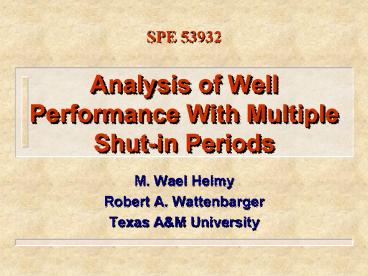Analysis of Well Performance With Multiple Shutin Periods PowerPoint PPT Presentation
1 / 62
Title: Analysis of Well Performance With Multiple Shutin Periods
1
Analysis of Well Performance With Multiple
Shut-in Periods
SPE 53932
- M. Wael Helmy
- Robert A. Wattenbarger
- Texas AM University
2
Gas Well Rate Decline
3
Objectives of Analysis
- Estimate OGIP
- Estimate flow properties
- Forecast production rates
4
Well Characteristics
- High pressure gas
- Constant Pwf
- Shut-in periods in summer
5
Well Characteristics
- Very tight rock k lt 0.01md
- Very long transient periods (10-20 years)
- Linear flow
6
Problem to Solve
7
Problem to Solve
8
Gas Well Rate Decline
9
Outline
- Introduction
- Superposition
- Analytical Solution
- Production Rate Filter
- Conclusions
10
Introduction
- Linear Flow, Fractured Wells
11
Introduction
- Linear Flow, Anisotropic Reservoirs
12
Introduction
Unit slope
Exponential
½ slope
13
Introduction
From slope k1/2/Ac From time Vp
14
Introduction
15
Introduction
16
Operating Conditions
- During production
- Constant pwf
- During shut-in
- Constant rate 0
17
Outline
- Introduction
- Superposition
- Analytical Solution
- Production Rate Filter
- Conclusions
18
Superposition
- Van-Everdingen and Hurst (1949)
- Linear, closed
- Linear, infinite
- Match bottomhole pressure
19
Constant pwf Solution
- For all models
20
Application
- Excel spreadsheet, Visual Basic
- Different models
- Reservoir properties and OGIP
Run Program
21
Curve-fitting Comparison
- The method is NOT curve-fitting
- Curve fitting gives wrong answers
- Constant pwf solution
22
Curve-fitting Comparison
23
Curve-fitting Comparison
24
Curve-fitting Comparison
25
Outline
- Introduction
- Superposition
- Analytical Solution
- Production Rate Filter
- Conclusions
26
Analytical Solution
27
Analytical Solution
- Convolution integral
- Linear flow model, infinite acting
28
Analytical Solution
- Laplace space solution is difficult
- Solve using Abels Integral equation
29
Analytical Solution
- Cumulative production
30
Analytical Solution
31
Average Production
32
Average Production
Over-shoot
Under-shoot
33
Operating Conditions
- What we know
- Average monthly production
- Constant pwf (when producing)
- What we dont know
- Duration of shut-in during the month
- Time shut-in started during the month
34
Analytical Solution
- Obtain trend line
- Calculate duration of shut-in
- Determine time shut-in started
35
Application
36
Application
37
Application
38
Outline
- Introduction
- Superposition
- Analytical Solution
- Production Rate Filter
- Conclusions
39
Production Rate Filter
- Analytical solution depends on
- Shut-in period
- Time shut-in started
- Production rate filter
- Use average monthly production
- Independent of shut-in time
40
Production Rate Filter
41
Production Rate Filter
- Production rate correction
42
Production Rate Filter
- Linear flow model, infinite acting
43
Production Rate Filter
44
Production Rate Filter
45
Production Rate Filter
46
Outline
- Introduction
- Superposition
- Analytical Solution
- Production Rate Filter
- Conclusions
47
Conclusions
- Worked problem in three different and independent
ways - Superposition
- Analytical solution
- Rate-filtering techniques
48
Conclusions
- Superposition
- Stable, pressure not needed at all times
- Models used
- Linear, infinite acting
- Linear closed reservoir
- Obtained production trend
- Rate curve-fitting gives wrong results
49
Conclusions
- Analytical solution
- Solution for rate and cumulative
- Over-shoot and under-shoot correlation
- Determine shut-in time, if unknown
- Obtained production trend
50
Conclusions
- Production rate filter
- Filter rate independent of pressure
- Infinite acting reservoir model
- Obtained production trend
- All three methods match very well
51
Introduction
Rate -½ slope
Cumulative ½ slope
52
Problem to Solve
53
Literature Review
- Multiple shut-in º variable rate
- Literature focuses on variable-rate
pressure-transient analysis - Back-calculate constant rate solution from the
measured variable rate performance --
Deconvolution
54
Literature Review
- Bostic et al. (1979)
55
Literature Review
- Convolution
- Calculate variable rate solution
- Deconvolution
- Calculate constant rate solution
56
Literature Review
- Deconvolution before 1979
- Gladfelter et al. (1955)
- Divide pressure by rate
- Odeh and Jones (1965)
- Pseudo time function
57
Literature Review
- Deconvolution peaked in the 1980s
- Thompson et al. and Kuchuk et al.
- Different schemes to improve stability
- Kuchuk et al. (1983)
- Function deconvolution
58
Literature Review
- Kuchuk et al. (1985)
- Constrained deconvolution
- Coats et al. (1964)
59
Literature Review
- Roumboutsos et al. (1988)
- Laplace space deconvolution
- Blasingame et al. (1989)
- Power law deconvolution
- b deconvolution (exponential)
60
Literature Review
- Problems with deconvolution
- Recursive equation, unstable
- Requires monotonically decreasing rates for
stability - Requires rate and pressure data at each time step
61
Convolution
- Van-Everdingen and Hurst (1949)
62
Objectives
- Develop methodology to analyze performance with
multiple shut-ins - Superposition
- Analytical solution
- Rate-filtering techniques

